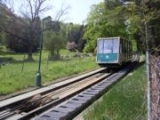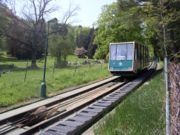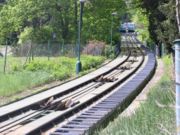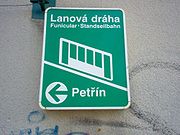
Petrín funicular
Encyclopedia



Funicular
A funicular, also known as an inclined plane or cliff railway, is a cable railway in which a cable attached to a pair of tram-like vehicles on rails moves them up and down a steep slope; the ascending and descending vehicles counterbalance each other.-Operation:The basic principle of funicular...
in the Czech
Czech Republic
The Czech Republic is a landlocked country in Central Europe. The country is bordered by Poland to the northeast, Slovakia to the east, Austria to the south, and Germany to the west and northwest....
capital city of Prague
Prague
Prague is the capital and largest city of the Czech Republic. Situated in the north-west of the country on the Vltava river, the city is home to about 1.3 million people, while its metropolitan area is estimated to have a population of over 2.3 million...
. It links the Malá Strana
Malá Strana
Malá Strana is a district of the city of Prague, Czech Republic, and one of its most historic regions.The name translated into English literally means "Little Side", though it is frequently referred to as "Lesser Town", "Lesser Quarter", or "Lesser Side"...
district with the top of Petřín
Petrín
Petřín is a hill in the center of Prague, Czech Republic. It rises some 130 m above the left bank of the Vltava River. The hill, almost entirely covered with parks, is a favorite recreational area for the inhabitants of Prague...
hill. The funicular has three stops: Újezd (at the bottom of the hill), Nebozízek (the middle station) and Petřín (at the top of the hill). According to Czech legend, the name of the middle station stems from an incident in which Emperor Charles IV
Charles IV, Holy Roman Emperor
Charles IV , born Wenceslaus , was the second king of Bohemia from the House of Luxembourg, and the first king of Bohemia to also become Holy Roman Emperor....
, requesting food, was unable to properly pronounce the Czech words "nebo řízek" (meaning, "or schnitzel"). – the word Nebozízek means diminutively one of types of auger.
The line was originally opened in 1891, with a length of 383 metres, a track gauge of 1 metre, and water balance propulsion. This original line closed with start of the First World War
World War I
World War I , which was predominantly called the World War or the Great War from its occurrence until 1939, and the First World War or World War I thereafter, was a major war centred in Europe that began on 28 July 1914 and lasted until 11 November 1918...
in 1914 and did not reopen after the end of hostilities. The current longer line opened in 1932 with a different track gauge and completely new equipment, and operated throughout the Second World War
World War II
World War II, or the Second World War , was a global conflict lasting from 1939 to 1945, involving most of the world's nations—including all of the great powers—eventually forming two opposing military alliances: the Allies and the Axis...
. However an earth movement in 1965 caused the service to be suspended, and it was not resumed until 1985. At that time new cars were provided and the track reconstructed, but the original machinery retained.
Although design and architecture of the stations are similar to Prague Metro, the funicular is actually operated by the trams division of the city transport company.
The funicular has the following technical parameters:
- Length: 510 metres
- Height: 130 metres
- Maximum gradient: 29.5%
- Cars: 2
- Configuration: Single track with passing loop
- Track gauge: Standard (1435 mm)
- Capacity: 100 passengers per car
- Traction: Electricity

